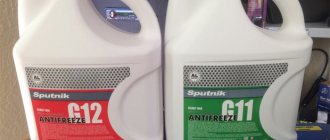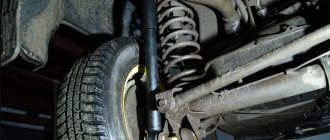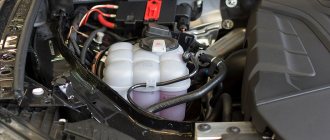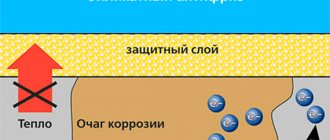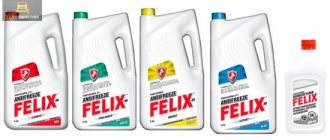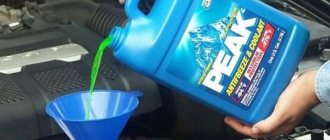Every car owner has at least once had the question of what would happen if you mixed several coolants of different brands. And also is it possible to mix antifreezes of different colors, how blue differs from red and similar thoughts. We will consider these and other questions below so that the reader does not use chemicals in the garage and damage his car.
It is worth noting that, subject to certain conditions, some antifreezes can be mixed. If you do not comply with them, you are guaranteed to “kill” the radiator in two to three years. And it will not be possible to restore it. Therefore, you should think carefully before exposing your car to such a risk.
Differences between antifreeze and antifreeze.
Today, three types of coolants for internal combustion engines are used: water (distilled or pure rainwater), antifreeze and antifreeze.
Antifreeze is the name of the liquid (translated as “anti-freeze”) for the engine cooling system, which does not freeze and can withstand high temperatures.
Standard composition of antifreeze for cars:
- Water.
- Ethylene glycol.
- Glycerol.
- Alcohol.
- Acid salts or carbonate additives.
Composition of antifreeze:
- Water.
- Anti-corrosion additives.
- Burates and phosphates.
- Alcohols.
- Glycols.
- Nitrites.
- Silicates.
- Nitrates.
Differences:
- antifreeze was invented later than antifreeze;
- Antifreeze is better in terms of environmental friendliness;
- The boiling point of antifreeze is higher;
- The freezing point of antifreeze is lower;
- Antifreeze provides better protection against corrosion.
- Antifreeze forms a protective film, but antifreeze does not, and therefore antifreeze cools much more efficiently.
- The service life for which antifreeze is designed is 6 times less than that of antifreeze.
- antifreeze protects engine cylinder liners from cavitation (air bubbles).
- The service life of the pump (pump) is significantly reduced if antifreeze is used.
- antifreeze does not clog radiators, and various types of deposits do not form.
The main disadvantage of antifreeze is that when heated to 105 degrees, its properties deteriorate.
Antifreeze boils when heated to 115 degrees and does not leave sediment in the channels and can be used for up to 250,000 km.
What happens if you mix antifreeze with antifreeze?
Firstly, the question is why mix these two different refrigerants. Well, various circumstances happen on the road, for example, there is an antifreeze leak and after eliminating the leak, you need to add antifreeze. But there is not always a canister of antifreeze in the trunk, and here they sell antifreeze nearby on the side of the road. You have to buy it and top it up to continue moving forward.
Or, as often happens, sooner or later after buying a used car, you have to top up the coolant, and then the driver asks the question: what was filled in before? Color is easy to determine, but classes are difficult. In such cases, experts recommend, again, not to save, but to drain the old fluid and fill in the new one in full. It is even possible that the old one has expired.
But, let's look at what happens after adding antifreeze to antifreeze.
From the composition we know that they only have in common water and, perhaps, a standard (ethyl alcohol). And each manufacturer adds different additives and additives in different quantities. Therefore, when mixing antifreeze and antifreeze, a sediment may form that will settle in the channels and on engine parts, which will gradually reduce the life of the internal combustion engine. Nothing bad will happen when adding antifreeze to antifreeze if their components are basically the same, but this cannot be checked with your own hands without a chemical laboratory.
Based on the above, we conclude that if you already had to mix antifreeze and antifreeze, then upon arrival, it is better to drain this liquid, do a complete flush of the engine cooling system and fill in a new homogeneous mixture. The cost of buying new antifreeze will save you a lot of money, effort and time.
Liquid cooling system
Liquid or water engine cooling systems are incredibly popular and common among automakers. Initially, ordinary water was used for such purposes. The advantage was that it was easy to get even in extreme situations.
However, water as a coolant has its disadvantages:
- corrosion begins quickly;
- when using dirty water, it is necessary to flush the system;
- low freezing temperature;
- rapid boiling;
- active evaporation;
- frequent engine failure;
- the need for constant monitoring of the cooling system;
- a large amount of sediment when using untreated water, etc.
Manufacturers realized that you can’t go far on water. First, glycerin and alcohol were added to the water. The composition has improved and modernized. As a result, we received special coolant, which is called antifreeze. The concept of antifreeze is also actively used in the post-Soviet space.
Let's look a little at the classification so that you can further understand whether motorists can mix compounds in certain situations. Namely:
- different brands;
- different manufacturers;
- different colors, etc.
Some are sure that antifreeze and antifreeze should never be mixed. Others believe that even if you mix red with green, red with blue, or yellow with any other colors of coolant, absolutely nothing terrible will happen. So we will find out who is right.
Is it possible to mix different brands of antifreeze?
Let's start with what classes of antifreeze there are. This:
Antifreeze G11 is a liquid of inorganic origin and contains silicates. Available in blue or green colors. Suitable for old cars.
Antifreeze G12 is a liquid of organic origin. Produced in pink and red flowers.
Antifreeze g11 and g12 what is the difference
The difference between antifreeze g11 and g12 is that inorganic G11 contains substances that protect against corrosion (inhibitors). Thanks to corrosion inhibitors, a film is created on parts and protects it from contact with oxygen, which causes the metal to rust. Antifreeze GI 11 is glycol-based, that is, if you do not add corrosion inhibitors, the aggressive glycol will begin to corrode metal parts. OX G11 must be changed at least once every 2-3 years. The common color of JI-11 is green. Green G11 is the lowest class.
As for G12 class antifreezes, they are based on carbosilicates. Since many parts in an internal combustion engine are made of aluminum and steel, upon contact with liquids, destructive films are formed on their surfaces. The additives contained in GI 12 prevent the formation of a destructive film (the technology is called Long life). The substances in G12 do not form a protective film on all surfaces of channels and parts, but only where pockets of corrosion have appeared, in order to protect against further destruction of the metal. This class of antifreeze begins to boil at a temperature of 120 degrees. Service life 5 years.
A little classification
Currently, 6 compositions are used for automobile engines, or more precisely for their cooling systems:
They can be from different companies, the same color, different shapes, types, etc. That is, color is not a fundamental criterion here. Therefore, one type of composition can be blue and green, yellow and red, etc.
Let me tell you about each composition separately.
- Antifreeze. An old type of antifreeze, developed during the USSR specifically for Soviet cars as a response to imported antifreeze. Consists of a regular aqueous solution using complex alcohols. This includes ethylene glycol and special protective additives;
- G11. Traditional coolant based on ethylene glycol, water and additives. Silicates, phosphates, as well as borates, nitrites, etc. are used as additives. They do not have long service life. Main color is blue;
- G12. Carboxylate automobile antifreezes, to which, in addition to the components from G11, carboxylates are added. These are compounds of a fairly effective carboxylic acid. The coolant lasts a long time, the composition is mainly painted red or pink;
- G12+. A hybrid fluid based on water, as well as ethylene glycol, carboxylate, silicate, nitrite and phosphate additives. The composition of the coolant may vary depending on the manufacturer and its geographical location. Mostly red;
- G12++. So-called hybrid liquids. An organic base and silicates are used. In many ways similar to G12+ antifreeze, but has a longer service life;
- G13. A new type of coolant, where ethylene glycol was abandoned and replaced with propylene glycol. This component is harmless, which is why it quickly gained popularity. It comes in pink and purple most often.
But you must understand that any of the antifreeze presented can be painted in completely different colors. This has nothing to do with the composition. Color is a purely decorative component.
Initially, manufacturers wanted to stand out by changing the color of the standard white liquid. But gradually everyone began to use different coloring options. Dyes are used for this.
Is it possible to mix antifreeze with water?
Since antifreeze contains a significant amount of water, if you add water to antifreeze, nothing bad will happen. Dilution simply occurs and concentration decreases. The more water you add, the worse the antifreeze properties will become.
But sometimes it is recommended to add water to antifreeze. This approach is used when antifreeze has boiled, causing water to evaporate and the remaining liquid in the cooling system to become highly concentrated. But when adding, you need to know the proportions. Excessive amounts of water will cause rust to appear in the cooling system.
Attention: mixing water with antifreeze is only possible in summer. At sub-zero temperatures, such diluted coolant can quickly seize and freeze.
If such antifreeze freezes, you will have to invest in repairs in the car components. Usually, when the coolant freezes, the radiator of the stove and engine ruptures, as well as pipes burst and hoses crack.
Even if the antifreeze was boiling and it became highly concentrated, it is better to add antifreeze of the same class and brand. In winter, it is safer to operate the car with high concentration antifreeze.
The conclusion about adding water to antifreeze is this: if you had to add water, then add a little.
When adding antifreeze, add only antifreeze of the same class that was added previously (G11, G12, G12+, G13) and the same color. Antifreeze class G-13 is based on propylene glycol.
General recommendations for adding antifreeze
Finally, here are a few general facts regarding topping up that will be useful for any car enthusiast to know.
- If the car uses a copper or brass radiator with cast iron engine blocks, then the simplest class G11 antifreeze (usually green or blue, but this needs to be specified on the packaging) must be poured into its cooling system. An excellent example of such cars are domestic VAZs of classic models.
- In the case when the radiator and other elements of the car engine cooling system are made of aluminum and its alloys (and most modern cars, especially foreign cars, are such), then more advanced antifreezes belonging to classes G12 or G12+ must be used as a “coolant”. . They are usually pink or orange in color. For the newest cars, especially the sports and executive class, you can use lobride antifreeze types G12++ or G13 (this information should be clarified in the technical documentation or in the manual).
- If you do not know what kind of coolant is currently poured into the system, and its level has dropped very much, you can add up to 200 ml of distilled water or G12+ antifreeze . Fluids of this type are compatible with all of the coolants listed above.
- By and large, for short-term work, you can mix any antifreeze, except for the domestic “Tosol”, with any coolant, and you also cannot mix antifreezes like G11 and G12. Their compositions differ, so the chemical reactions that arise during mixing can not only neutralize the protective effects of the mentioned coolants, but also destroy the rubber seals and/or hoses in the system. And remember that you cannot drive for a long time with a mixture of different antifreezes! As soon as possible, flush the cooling system and fill with the antifreeze recommended by the manufacturer of your car.
- The ideal option for adding (mixing) antifreeze is to use the product from the same canister (bottle). That is, you buy a large-capacity container, and only fill part of it into the system (as much as the system needs). And store the rest of the liquid in the garage or carry it with you in the trunk. This way you will never go wrong with the choice of antifreeze for topping up. However, when the canister runs out, it is recommended to flush the engine cooling system before using new antifreeze.
Following these simple rules will allow you to keep your engine cooling system in working order for a long time. In addition, remember that if antifreeze does not perform its functions, this can lead to an increase in fuel consumption, a decrease in the service life of the engine oil, and the risk of corrosion on the internal surfaces of the cooling system parts, even to the point of destruction.
Is it possible to mix antifreeze of different colors?

